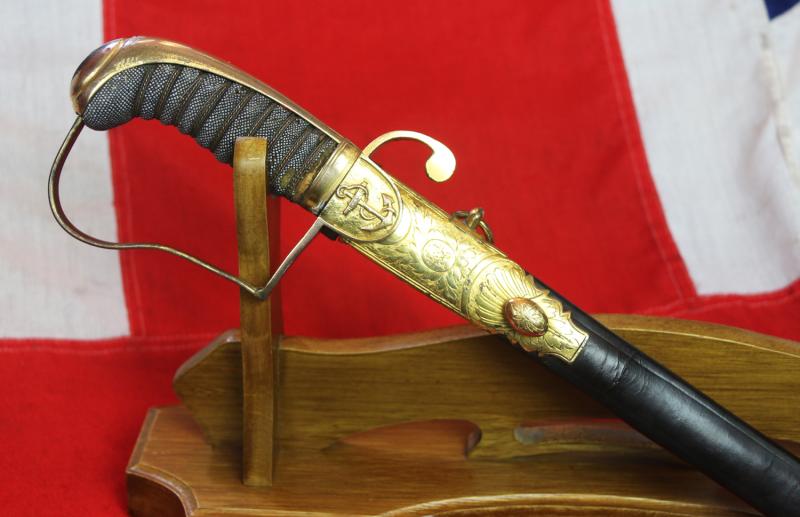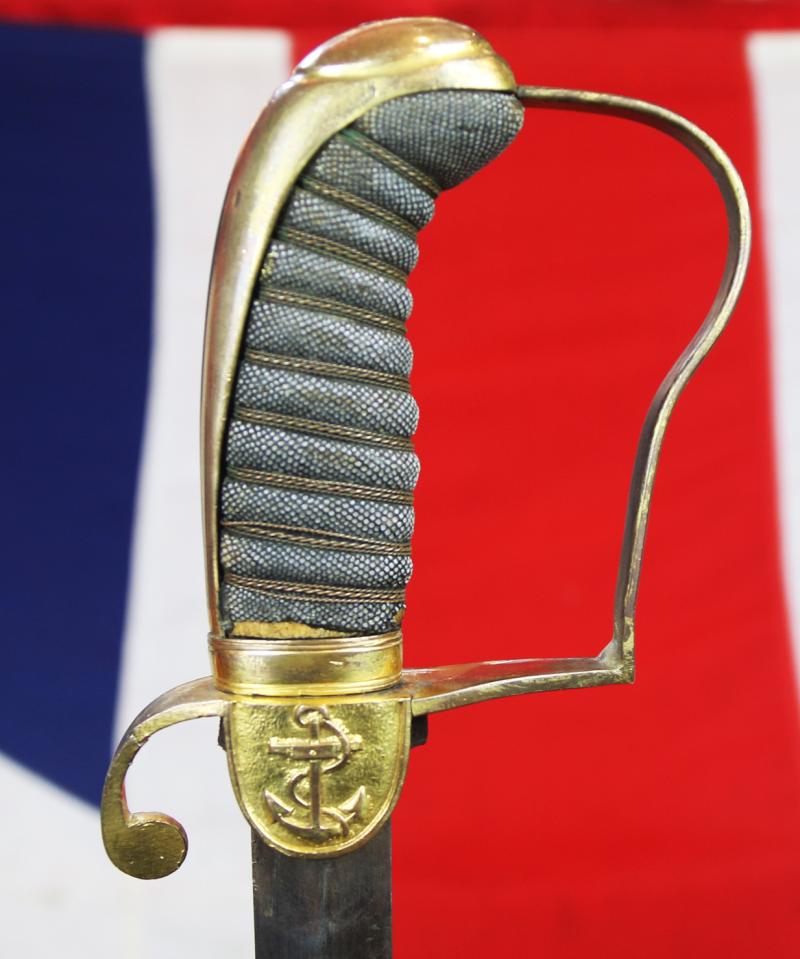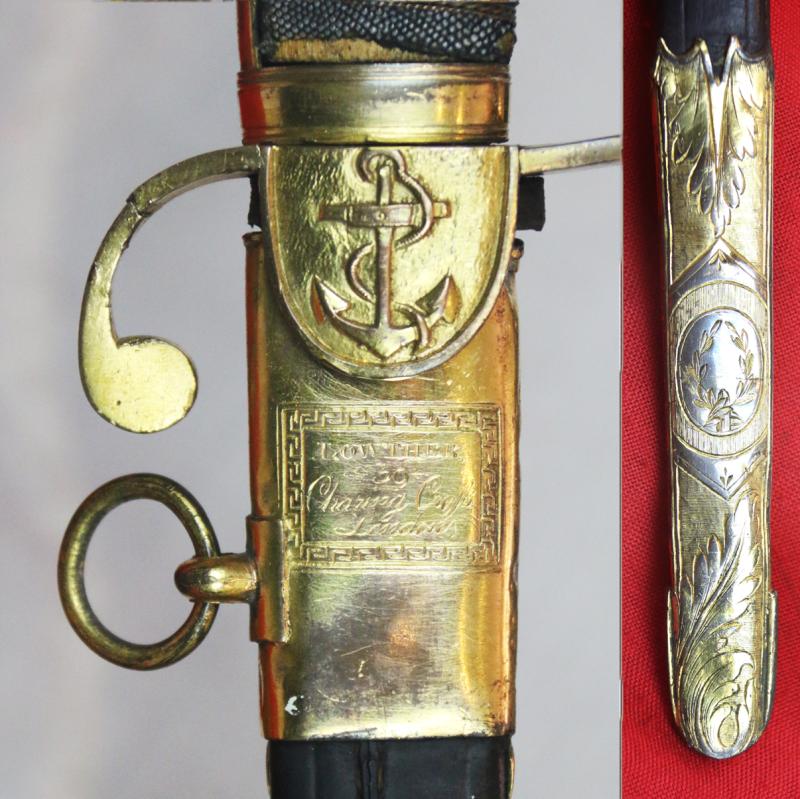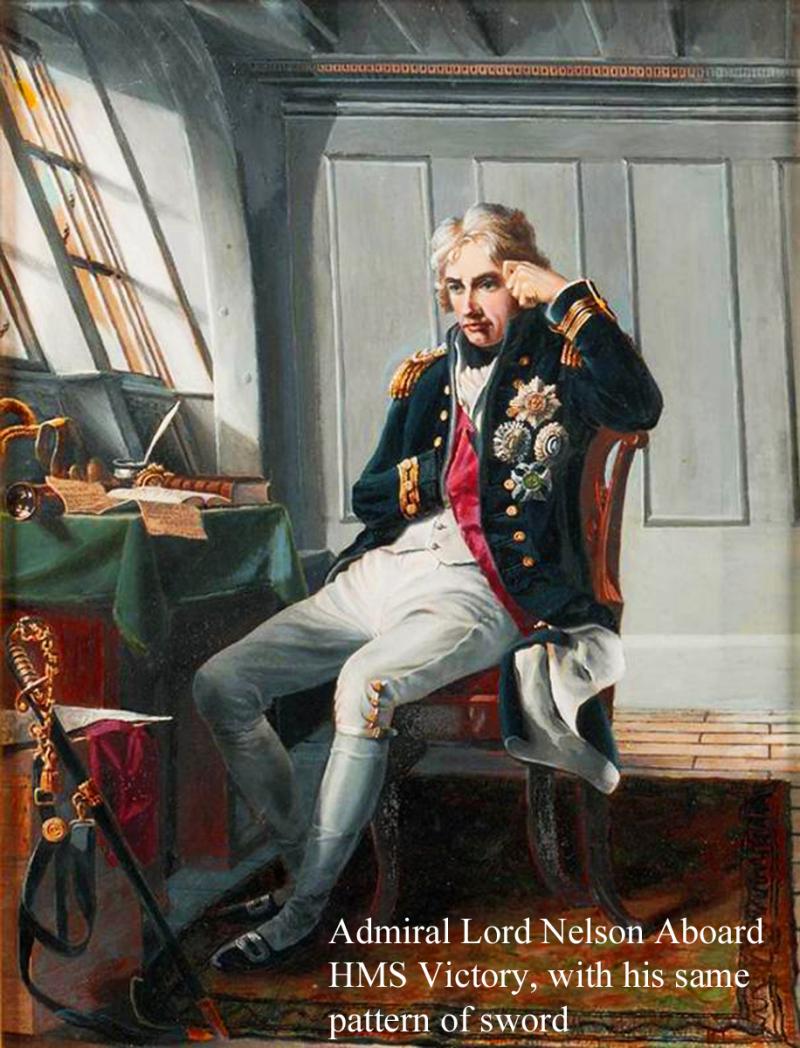A Magnificent Quality Original Royal Naval Officer's Sword, Of An Officer Serving in Admiral Horatio Nelson's Navy, From the Battle of Trafalgar Period of 1805. Made in Charing Cross London
A combat cum dress sword, with around 85% original mercurial gilt remaining, diamond form double edged blade. Finest copper gilt stirrup hilt, with dove's head pommel, with a pair of cast fouled-anchor langets, wire bound sharkskin grip. Fabulous original scabbard with matching mounts of the highest quality, embellished with stunning decor upon the original mercurial gilt.
We show an original painting from the era of a young lieutenant carrying in his arm his identical sword type.
Superb sword of an officer serving in the Royal navy in the Nelson era. Its hilt and scabbard has been stunningly well preserved these past 190 years, considering its age and combat service.
There were numerous officer's, lieutenants, serving on Nelson's flagship, who carried extremely similar swords to this fine sword. One junior officer who wore the same sword was young Festing Horatio Grindall, who served in the navy before, during and subsequent to the battle, until he died one year after his brother in 1812. His father was Captain Grindall of HMS Prince at Trafalgar, later promoted after the battle to Rear Admiral of the Blue.
Thanks to his long and favourable service record, Grindall was made a Rear Admiral of the White on 28 April 1808, of the Red on 25 October 1809 and Knight Commander of the Order of the Bath on 2 January 1815, in the general promotion which followed the action on 9 November. However, this meant the effective end of his
career, as so many admirals were created that not enough posts could be found for them. Grindall was one of the promoted men who never commanded at sea again, taking a shore appointment in late 1805 and retiring with his family soon afterwards as a Vice Admiral of the Blue on 31 July 1810, of the White on 12 August 1812, and of the Red on 4 June 1814. His retirement was a difficult one however, as two of his sons who had joined the navy in their father's footsteps, Edmund and Festing, died in 1811 and 1812 from unconnected illness. When Richard Grindall died in Wickham in 1820 he was interred next to them at St Nicholas Church, Wickham, Hampshire, joined by his wife Katherine in 1831. Katherine before her death had passed on both her son's officer's swords to her last remaining senior family member.
Before the battle was won, and the French struck their colours, Nelson fell, mortally wounded, shot through the shoulder and spine by a french sniper.
The young junior officer's assisted the crew to carry Nelson below after his fatal wound, also present was great friend Capt. Hardy, and his surgeon William Beatty.
We were incredibly fortunate to acquire this sword the 1805 light pattern, combat-cum-dress sword.
The Battle of Trafalgar (21 October 1805) was a naval engagement fought by the Royal Navy against the combined fleets of the French and Spanish Navies, during the War of the Third Coalition (August?December 1805) of the Napoleonic Wars (1803-1815).
Twenty-seven British ships of the line led by Admiral Lord Nelson aboard HMS Victory defeated thirty-three French and Spanish ships of the line under the French Admiral Villeneuve in the Atlantic off the southwest coast of Spain, just west of Cape Trafalgar, in Canos de Meca. The Franco-Spanish fleet lost twenty-two ships, without a single British vessel being lost. It was the most decisive naval battle of the war, conclusively ending French plans to invade England.
The British victory spectacularly confirmed the naval supremacy that Britain had established during the eighteenth century and was achieved in part through Nelson's departure from the prevailing naval tactical orthodoxy. This involved engaging an enemy fleet in a single line of battle parallel to the enemy to facilitate signalling in battle and disengagement, and to maximise fields of fire and target areas. Nelson instead divided his smaller force into two columns directed perpendicularly against the enemy fleet, with decisive results.
Nelson was shot by a French musketeer during the battle and died shortly after, becoming one of Britain's greatest war heroes. Villeneuve was captured along with his ship Bucentaure. Admiral Federico Gravina, the senior Spanish flag officer, escaped with the remnant of the fleet and succumbed months later to wounds sustained during the battle. Villeneuve attended Nelson's funeral while a captive on parole in Britain.
Smaill combat hairline at the rear-side quillon downturn midline {see photo 7}. Very small areas of shrinkage wear on the sharkskin grip at the lower end, fore and aft {see photos 5 and 6}
Code: 25412










